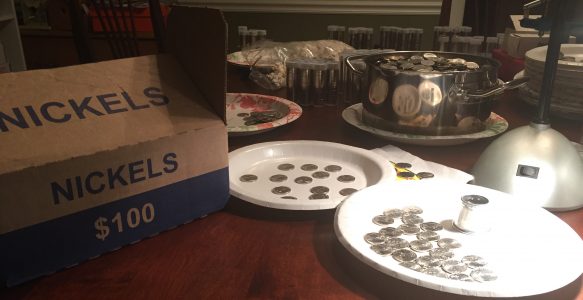One of my favorite Jefferson nickels is the 1975 nickel with a misplaced mintmark from the Denver Mint – the so-called High D. Normally, the mintmark is well below the five in the date, but in this variety it is next to the 5.

This is what NGC has to say about the variety:

In 2015 a famous numismatist, Q. David Bowers, put out a bounty on the coin: he would pay $500 for an uncirculated version of the coin and donate $1000 to a numismatic charity in the sellers name. No one took him up on his offer. Well Mr. Bowers, here is what you were looking for, but we are not selling!

Of the five coins in the NGC Census, this is the highest graded 1975 High D by far:

This coin also has the coveted QA sticker, which is a certification by a third party, QA Coins, that the grade given by NGC is accurate. They specialize in modern coins like Jefferson nickels so they know what they are talking about. Not sure if there any other nicer examples out there, but so far none have surfaced.
In my own census of examples in our family, there are nine examples of the 75 High D nickel:
- NGC MS-63 QA (above coin)
- NGC MS-62 with obverse cud which is a double error variety.

- NGC AU-58 with obverse cud (slabbed before High D was officially recognized); this die break may have shortened the life of this High D die, which could explain why they are so rare

Close ups


- NGC XF-45 (my Brother’s coin)

- NGC XF-40

- ANACS EF-40 DETAILS

- Lastly, three ungraded, circulated examples: one is my Dad’s (no pic) and the two below are mine


So why is this important? Why is this one of my favorite coins? I guess it is because this coin is really hard to find – the thrill of the chase. I have looked through at least a million nickels in the last 15 years, but I have only found two! My dad searched through 10,000 nickels a week for two years, and he has only found two. I vividly remember the call when he found his first 75 High D. He only had to say four words: “The Eagle Has Landed!” and I knew exactly what he meant. Ever since we saw this variety mentioned in A Guide Book of United States Coins (the “Red Book”), my brother, dad, and I were obsessed with trying to be the first to find one. Dad won the race, and we all celebrated together.

Another reason for this being one of my favorites is that it is a recently discovered variety. It took about 40 years for people like Bowers to take notice. By that time, most of these have become worn out. I estimate that out of 1000 1975 D nickels, only one or two are in any kind of decent shape. So finding an uncirculated 75 High D is like finding a unicorn.
And these 75 High D coins have been so thoroughly distributed over the last four decades that the only way to find them is by looking through thousands and thousands of nickels or getting very lucky . The sheer volume of nickels in circulation – tens of billions – makes it like winning the lottery if you find one. Unlike almost every other nickel, you can’t just go out and buy these (unless you happen to find one on ebay like I did last weekend 😁). They are nearly unobtainable, which makes them that much more desirable. In the coin world, like in life, the harder you have to work to get something, the more you appreciate it.
My last reason for liking this coin is that even though the 1975 High D nickel is one of the absolute rarities of 20th century American coins (IMHO), it is also one of the least known. NGC recognizes this variety, but PCGS does not. My EF-40 DETAILS example above was the first 75 High D graded by ANACS. Not one of the hundreds of dealers I have met at coin shows over the past few years has ever even heard of this variety. This anonymity has allowed me to quietly pick up five 75 High Ds without spending a fortune.
So get out there and find those 75 High Ds before the rest of the world discovers how cool and rare they are! I hope you get to tell your favorite person, “The Eagle Has Landed ” and they know exactly what you mean.
